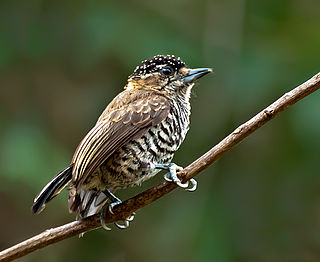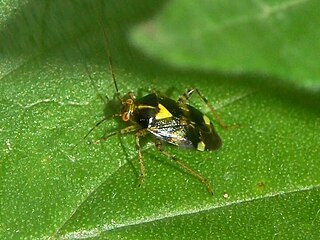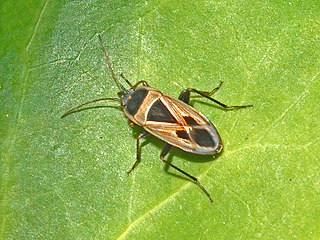
Apatura iris, the purple emperor, is a Palearctic butterfly of the family Nymphalidae.

Papilio demoleus is a common and widespread swallowtail butterfly. The butterfly is also known as the lime butterfly, lemon butterfly, lime swallowtail, and chequered swallowtail. These common names refer to their host plants, which are usually citrus species such as the cultivated lime. Unlike most swallowtail butterflies, it does not have a prominent tail. When the adult stage is taken into consideration, the lime swallowtail is the shortest-lived butterfly, with male adults dying after four days and females after a week. The butterfly is native to Asia and Australia, and can be considered an invasive pest in other parts of the world. The butterfly has spread to Hispaniola island in the Western Hemisphere, and to Mahé, Seychelles.

The mint moth is a small moth from the family Crambidae, also known by the common name Small Purple and Gold.

Lampides boeticus, the pea blue, or long-tailed blue, is a small butterfly that belongs to the lycaenids or gossamer-winged family.

Apatura ilia, the lesser purple emperor, is a species of butterfly native to most of Europe and east across the Palearctic. It is named for its similarity to the purple emperor butterfly.

The brown marmorated stink bug is an insect in the family Pentatomidae, native to China, Japan, Korea and other Asian regions. In September 1998 it was collected in Allentown, Pennsylvania, where it is believed to have been accidentally introduced. The nymphs and adults of the brown marmorated stink bug feed on over 100 species of plants, including many agricultural crops, and by 2010–11 had become a season-long pest in orchards in the Eastern United States. In 2010, in the Mid-Atlantic United States, $37 million in apple crops were lost, and some stone fruit growers lost more than 90% of their crops. Since the 2010s, the bug has spread to the nation of Georgia and Turkey and caused extensive damage to hazelnut production. It is now established in many parts of North America, and has recently become established in Europe and South America.

The black arches or nun moth is a small Palaearctic moth. It is considered a forest pest.

The banded broadbill is a species of bird in the typical broadbill family Eurylaimidae found in Mainland Southeast Asia and the Greater Sunda Islands. It is sometimes split into two species, one including only the nominate subspecies, E. j. javanicus, and one including all the remaining subspecies. It inhabits a variety of forests, along with forest edge, rubber plantations and Falcataria falcata groves, mainly in lowland areas. A striking, large-bodied bird with a length of 21.5–23.0 cm (8.5–9.1 in), it is unlikely to be mistaken for another species. The broadbill is mostly purplish-red, with yellow-streaked black wings, a bright blue beak, a blackish face and greyish chin and upper breast. Females can be told apart from males by their lack of a black neckband, although these are indistinct in Bornean and Javan males. Despite its conspicuous appearance, the bird is usually hard to see due to its sluggishness and is usually only noticed when it vocalises.

The white-barred piculet is a species of bird in the woodpecker family Picidae. It is found in Argentina, Bolivia, Brazil, French Guiana, Guyana, Paraguay, and Uruguay.

Melitaea phoebe, the knapweed fritillary, is a butterfly of the family Nymphalidae. It is found in the Palearctic realm, except the northernmost locations. It used to include Melitaea telona, recently revalidated as a distinct cryptic species.

Eurydema oleracea is a species of shield bug in the family Pentatomidae and is commonly known as the rape bug, the crucifer shield bug, the cabbage bug or the brassica bug.

Acraea petraea, the blood acraea or blood-red acraea, is a butterfly of the family Nymphalidae. It is found in coastal forests from KwaZulu-Natal to Mozambique, Kenya and Malawi.

Graphium colonna, the black swordtail or mamba swordtail, is a species of butterfly in the family Papilionidae (swallowtails). It is found in Africa.

Trichopoda pennipes is a species of feather-legged fly in the dipteran family Tachinidae.

Liocoris tripustulatus or the common nettle bug is a species of plant bug belonging to the family Miridae, subfamily Mirinae. The species was first described by Johan Christian Fabricius in 1781.

Harpocera thoracica is a species of bugs from Miridae family.

Stictopleurus crassicornis is a species of scentless plant bugs belonging to the family Rhopalidae, subfamily Rhopalinae.

Xanthochilus saturnius, the Mediterranean seed bug, is a species of true bugs belonging to the family Rhyparochromidae.

Raglius is a genus of dirt-colored seed bugs in the family Rhyparochromidae. There are about 11 described species in Raglius.
Platycheirus confusus, the Confusing Sedgesitter, is a species of syrphid fly in the family Syrphidae.



















